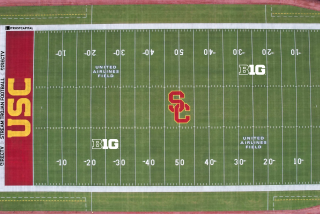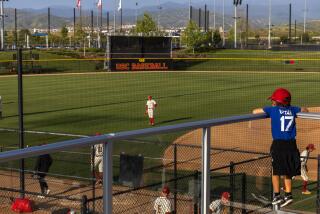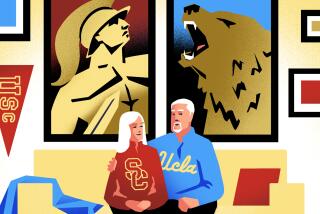At USC and Notre Dame, They Take This Game Very Seriously
There are singular moments of individual glory, so many of them. Six touchdowns in a game by USC’s Anthony Davis. A 56-yard, game-winning punt return by Notre Dame’s Tim Brown.
USC falling behind 24-0, then scoring 55 unanswered points. Notre Dame playing its starters until the bitter end, to preserve the shutout in a 51-0 win.
National titles have been won and lost; players have made themselves Heisman Trophy winners. Jersey colors have been changed, from Notre Dame’s traditional blue to kelly green, in hopes of gaining a psychological edge, as in a notable 1977 game in South Bend, Ind. And then there’s that Trojan white horse, the sight of which nearly made a Notre Dame coach physically ill.
USC versus Notre Dame is arguably college football’s greatest rivalry. The schools will play, Saturday afternoon in the Coliseum, for the 74th time and for the 57th consecutive year. Notre Dame leads the series 42-26-5, but those 26 Trojan victories are more than any other team has against the Fighting Irish. And Notre Dame’s 42 wins are the most by any USC opponent.
The rivalry aside, for the first time since 1988, when Notre Dame was ranked No. 1 and USC No. 2 in the country, this game has huge meaning for both teams. The winner should receive an invitation to one of the nation’s four biggest -- and richest -- postseason bowl games.
That’s how it is with these two teams, each always expecting greatness, from themselves and from each other.
The winner will also earn a shillelagh trophy that, according to legend, was flown from Ireland by Howard Hughes’ pilot. There are 42 emerald-studded shamrocks to represent the Notre Dame wins and 26 ruby-decorated Trojan heads for USC’s victories.
No fewer than 11 Heisman Trophy winners -- the award goes to college football’s best player -- have been produced by USC and Notre Dame. In 14 of the games, one of the teams went on to win a national title. Twice USC, in the last scheduled game of the season, has upset the Irish and cost them the national title.
The second time came in 1964. Trailing 17-0 at halftime, USC rallied to win, 20-17. The game-winning touchdown came with 1 minute, 33 seconds left on a fourth-down, 15-yard pass from Craig Fertig to Rod Sherman after defender Tony Carey had fallen down.
Fertig, a broadcaster for USC games on television, paid a visit to the Trojans’ practice Monday. “I busted into their meeting,” Fertig said, “and I was wearing a green sweater with a shamrock over my heart. I was a wild man. Coach [Norm] Chow [a USC assistant coach] told me to settle down a little bit because it was only Monday.
“But it’s a big game, it’s always been a big game, it always will be a big game.
“It’s hard to explain, but if you’re an SC person you will always have to play Notre Dame and if you’re a Notre Dame person, you’ll always have to play SC.”
This rivalry is about so much more than a trophy. It is about history.
“When I got to USC,” said Davis, who scored his six touchdowns against the Fighting Irish in 1972, “I studied about the past games. Did you know the first game was in 1926 and it was started by two women?”
Well, maybe.
USC’s traditional version of the story is that Marion Wilson, whose husband, Gwynn, was the Trojans’ athletics team manager (much like today’s athletic director), was on a train to Chicago along with the Notre Dame team, determined to convince Notre Dame Coach Knute Rockne that a series of games between USC and Notre Dame would be a good idea.
Rockne thought his team was traveling too much and didn’t like the idea of hauling the Irish halfway across the country on the train. But Marion was in a compartment with Rockne’s wife, Bonnie. The women hit it off. Bonnie told Knute she thought the game was a good idea.
And a legendary series was born.
“But there’s no truth to that story,” said Murray Sperber, author of “Shake Down the Thunder,” a history of Notre Dame football. “What happened was that the Los Angeles Coliseum had been recently built. USC people came to South Bend and offered a huge amount of money and Notre Dame accepted.”
It is the nation’s greatest intersectional football rivalry, according to historian Bernie Kish, director of the National College Football Hall of Fame. Since 1926, except for three years during World War II, the Fighting Irish have traveled some 2,000 miles to Los Angeles or the Trojans have traveled a similar distance to the Midwest.
Sperber called the team’s train travel west “a pilgrimage. The Fighting Irish train would go south to New Orleans, to Houston, across Arizona, to places with large Catholic populations, and when they came back they would go through San Francisco and Denver and take a long time at each of those stops. They were given parades and parties and it was an amazing journey.”
The maturation of the rivalry, in many ways, matched the maturation of this country.
“In the days before there were dozens of games on television, this game was the only game on TV all weekend. All football fans watched,” Kish said. “And people in the Midwest would see the Coliseum and the palm trees and the movie stars and people in Los Angeles would see the cold and the snow and all the Catholic history at Notre Dame.”
In the 1930s, Sperber said, “Notre Dame really liked going to the coast. They’d be feted by movie stars. Bing Crosby started coming to the games and he would throw a party and it was a great chance for Notre Dame to raise money. There were a lot of Hollywood movies and musicals made where USC and Notre Dame were featured prominently. It became a cultural thing as much as a sports rivalry.”
But it’s not the cultural significance that will draw 92,000 to the Coliseum Saturday.
It’s the hope of seeing history as it happens, of seeing another magical game, a special play, a myth-making performance.
The first game in 1926 drew 74,378, then the most ever to see Notre Dame play.
Afterward, Rockne called the 13-12 Irish win “the greatest game I ever saw.”
USC got its first win against the Irish in 1928, 27-14, and Rockne wasn’t happy. Notre Dame had conducted an open practice in Tucson and then a day later read about his plays in Los Angeles newspapers. “It serves me right to be nice to certain sportswriters,” Rockne said after the loss.
USC’s first two away games in the series -- at Chicago’s Soldier Field in 1927 and 1929 -- drew crowds of 120,000 and 112,912, the largest ever to watch USC play and two of the three largest to watch Notre Dame.
When USC won at South Bend for the first time in 1931, rallying from a 14-0 deficit for a 16-14 win and ending a 26-game Notre Dame winning streak, the national champion Trojans were welcomed home by a parade through the streets of Los Angeles that drew 300,000.
Fertig, one of the heroes of the 1964 game for USC, said his father was so mad at him for taking a recruiting trip to Notre Dame that “he didn’t speak to me for three days. He had given me a music box that played [the USC song] ‘Fight On.’ So after three days, he comes into my room. He didn’t say good night or go to hell or anything. He just flipped up the top of that music box and on came ‘Fight On.’ I understood.”
Last year, Fertig was in Chicago on the day before USC played at Notre Dame.
“I’m at lunch,” Fertig said, “and two guys come up and say, ‘You no good so and so,’ and they’re holding up a picture from the Los Angeles Times, 1964, and it’s of Sherman catching that pass. It turns out they were friends of Carey, the guy who had fallen down. So I invited them to eat lunch with us and told them to call Carey. They did. He wouldn’t come.”
After each of his six touchdowns in USC’s 45-23 win in 1972, Davis had done a little shake and shimmy end-zone dance.
A year later, when USC went to South Bend, Davis said, the deep meaning of the rivalry was obvious. Both teams were undefeated and emotions were high.
“We got off the bus,” Davis said, “and I was hanging in effigy.... I saw pictures of me all over campus, taped to the ground, so the students could walk on my face.” Notre Dame won the game, 23-14, and its ninth national title.
But in 1974, in what Joe Doyle, a South Bend Tribune writer and student of Notre Dame history, called the greatest 17 minutes of football he had ever seen, Davis starred as USC scored 55 straight points and turned a 24-0 first-half deficit into a 55-24 win.
Doyle, 82, said, “It was amazing football USC played. It wasn’t that Notre Dame was turning the ball over or playing badly.”
It was after that game that Ara Parseghian, who would soon announce he was quitting as Irish head coach, moaned that he was “damned tired” of seeing Traveler, USC’s white steed, high-step it around the stadium track after each USC touchdown. “Could you blame me?” he said.
Doyle, who will be in the Coliseum Saturday, rattles off highlights as if he were reading scores on a newscast.
“In 1966, Notre Dame won 51-0 to win the national title. In 1970, both were good teams and there was a tremendous rainstorm at the Coliseum. It started in the second quarter when USC had a slight lead. But Joe Theismann went out and had a tremendous game. He threw 58 passes, completed 33 for 526 yards. USC won, 38-28, though.”
Pat Haden, a Rhodes scholar who played at USC and has broadcast Notre Dame games, said the length of the series, its constancy, is what sets the USC-Notre Dame rivalry apart.
“I’ve always thought of this game as one of the few that is part of a long continuum,” Haden said. “I went to the game with my father. I’ve taken my kids to it and I anticipate my kids taking their kids to it. It’s a constant in an ever-changing sports landscape.”
Haden came from a Notre Dame family and his first memory is of the 1964 game. “I remember going to Thanksgiving Mass with the Notre Dame team,” Haden said. “My father was so excited. We sat up in the nosebleed section, Row 86 or something, and watched Craig Fertig ruin Notre Dame’s perfect season and national championship hopes.”
Another memorable game was in 1977, when Notre Dame Coach Dan Devine secretly ordered the Irish green jerseys -- instead of blue -- just for the USC game. Other than the Irish captains, none of the players knew what they’d be wearing until the team had come back to the locker room after pre-game warmups.
The Irish returned to the Notre Dame Stadium turf to be greeted by stunned silence, then ear-shattering noise.
Notre Dame romped, 49-19, for Devine’s only win over the Trojans in his six seasons as coach.
The late Marv Goux, known as Mr. Trojan until his death earlier this year, was both a player and coach for USC.
His widow, Patti, who will participate in the coin toss Saturday, said her husband once described his walk up the tunnel at Notre Dame. “Marv said the tunnel was fairly narrow, then you walk out and the opponents are right there..... You’re looking at the field and there’s the sun shining on the cardinal and gold leaves of autumn.”
Patti laughed at this, Marv making the South Bend leaves into USC talismans.
Last year, Patti said, Marv went to USC practice during Notre Dame week. “Marv had formed a real bond with [first-year USC Coach] Pete Carroll,” Patti said. “Marv talked to the team and to Pete and tried to convey the meaning of this game. He told them about going up the tunnel and the leaves.
“When the game is in South Bend, kickoff is always 11:30 our time. About 10 a.m., the phone rang and it was Pete. He had the cell phone in his hand. He told Marv he was walking out the tunnel. ‘I had to tell you,’ Carroll told Goux, ‘it’s just like you said it would be.’ That meant the world to Marv.”
Fertig said the magnitude of the rivalry was never clearer than after that 1964 game.
“After we won that game,” he said, “we had a team party. A guy that worked for the L.A. Times, he had collected newspapers from all over the world.
He had papers from London, Frankfurt, Munich, Paris. And on the front page of all those papers, there was the story about USC and Notre Dame. I still have those papers.”
More to Read
Go beyond the scoreboard
Get the latest on L.A.'s teams in the daily Sports Report newsletter.
You may occasionally receive promotional content from the Los Angeles Times.






